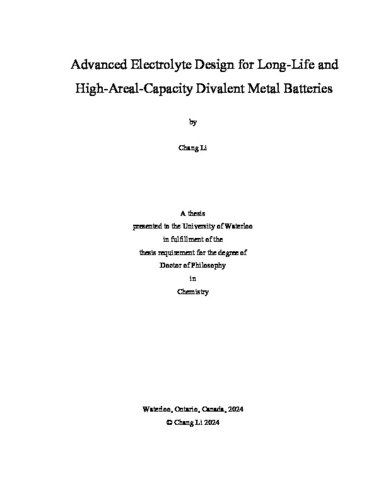| dc.description.abstract | Net-zero carbon dioxide emission demands clean renewable energy, while harnessing it requires electrochemical storage devices with high energy density, safety and affordability. To achieve decarbonization, much effort is being devoted to new battery technologies beyond lithium-ion batteries (LIBs), which suffer from limited lithium resources and low safety. Rechargeable batteries based on divalent metal anodes (Zn, Mg and Ca) are promising systems due to their high abundance, high volumetric capacity and potentially high safety. Zn anode has a high standard redox potential (-0.76 V vs. standard hydrogen electrode (SHE)), resulting in its relatively good compatibility with aqueous electrolytes. Such inherent safety and potential low-cost make aqueous Zn metal batteries (AZMBs) desirable candidates for small and large-scale stationary grid storage. Mg or Ca anode, on the other hand, has a much lower standard redox potential (-2.37 V or -2.87 V vs. SHE, respectively) that is even comparable to lithium (-3.04 V vs. SHE). Therefore, high-voltage rechargeable Mg or Ca metal batteries (MMBs or CMBs) are potential alternatives to LIBs in a variety of areas ranging from portable electronic devices to electrical vehicles. However, the study of these divalent metal batteries is still at the early stages. Among many unaddressed challenges for practical divalent metal batteries, designing better electrolytes is one key to their successful commercialization. This thesis presents a comprehensive investigation on designing new electrolytes for both AZMBs (chapters 3, 4 and 5) and MMBs (chapters 6 and 7), by tuning the solvation structure of Zn2+ or Mg2+ ions and their interaction with solvents or anions. A series of electrolytes with precisely controlled interfacial electrolyte/electrode chemistry are developed to achieve rechargeable AZMBs and MMBs under practical conditions.
Chapter 3 reports a novel additive - N,N-dimethylformamidium trifluoromethanesulfonate (DOTf) - in a low-cost aqueous electrolyte that enable near 100% coulombic efficiency of Zn plating/striping at a combined high current density of 4 mA cm-2 and areal capacity of 4 mAh cm-2 over long-term cycling. The water-assisted dissociation of DOTf into triflic superacid creates a robust nanostructured SEI - as revealed by operando spectroscopy and cryo-microscopy - which excludes water and enables dense Zn deposition. Zn||Zn0.25V2O5·nH2O (ZVO) full cells based on this modified electrolyte retain ~83% of their capacity after 1000 cycles with mass-limited Zn anodes. By restricting the depth of discharge, the cathodes exhibit less proton intercalation and LDH formation with an extended lifetime of 2000 cycles.
Chapter 4 presents the electrochemical degradation mechanism of LiV2(PO4)3 (LVP) as a host cathode in AZMBs. Phase conversion of LVP induced by H+ intercalation is observed in 4 m Zn(OTf)2 whereas dominant Zn2+ insertion is confirmed in ZnCl2 water-in-salt electrolyte (WiSE). This disparity is ascribed to the complete absence of free water and the strong Zn2+-H2O interaction in the latter that interrupts the H2O hydrogen bonding network, thus suppressing H+ intercalation. Based on this strategy, a novel PEG-based hybrid electrolyte is designed to replace the corrosive ZnCl2 WiSE. This system exhibits an optimized Zn2+ solvation sheath with a similar low free water content, showing not only much better suppression of H+ intercalation but also highly reversible Zn plating/stripping with a CE of ~99.7% over 150 cycles.
Chapter 5 reveals the competition between Zn2+ vs proton intercalation chemistry of typical ZVO cathode using ex-situ/operando techniques, and alleviate side reactions by developing a cost-effective and non-flammable hybrid eutectic electrolyte. A fully hydrated Zn2+ solvation structure facilitates fast charge transfer at the solid/electrolyte interface, enabling dendrite-free Zn plating/stripping with a remarkably high average coulombic efficiency of 99.8% at commercially relevant areal capacities of 4 mAh cm-2 and function up to 1600 hours at 8 mAh cm-2. By concurrently stabilizing Zn redox at both electrodes, we achieve a new benchmark in Zn-ion battery performance of 4 mAh cm-2 anode-free cells that retain 85% capacity over 100 cycles at 25 C. Using this eutectic-design electrolyte, Zn||Iodine full cells are further realized with 86% capacity retention over 2500 cycles. The approach represents a new avenue for long-duration energy storage.
Chapter 6 reports a low-cost inorganic membrane that forms an effective protection film on the Mg surface to stabilize Mg plating/stripping. It significantly reduces the population (and hence decomposition) of free diglyme (G2) molecules at the Mg/interface, while allowing facile transport of Mg2+ cations, leading to dendrite-free Mg deposition in a magnesium tetrakis(hexafluoroisopropyloxy)borate/G2 electrolyte. We demonstrate very stable Mg plating/stripping performance with a 750-fold extended lifetime (over 6000 hours) with a high coulombic efficiency of ~98%. The prototype Mo3S4 cathode paired with inorganic membrane-protected Mg anode shows 91% capacity retention over 200 cycles. More importantly, this membrane also protects soluble species in a high-voltage organic polymer cathode from being reduced at the anode via shuttling, achieving a full cell with a 3.5 V cutoff voltage and 1.4 V average discharge voltage. This results a high specific energy density of 320 Wh kg-1 and power density of 1320 W kg-1 based on cathode mass.
Chapter 7 report a new and easily accessible co-ethereal phosphate electrolyte system for high-voltage rechargeable MMBs, which very effectively solves the difficulty of ion pair dissociation and facilitates fast nanoscale Mg nucleation/growth for the first time, enabling facile interfacial charge transfer at current densities up to 10 mA cm-2. Dendrite-free Mg plating/stripping is achieved for over 6000 hours (8.3 months) at a practical areal capacity of 2 mAh cm-2. The four-volt oxidative stability of these electrolytes - in conjunction with a polyaniline cathode with an upper potential of 3.5 V and a Mg metal anode - enables cells with stable cycling at a 2C rate for over 400 cycles at 25 C. We believe our work opens up new frontiers in developing low-cost and fast-charging MMBs with long life and high energy densities. | en |

